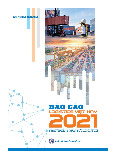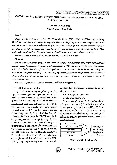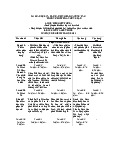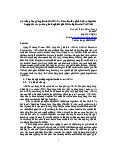



Preview text:
ILRI RESEARCH BJuRlyIE 2F0 1991 1 4 6
Overview of typical pork value chains in Vietnam
Fred Unger, Nguyen Thi Thinh, Pham Van Hung, Le Thi Thanh Huyen, Nguyen Viet Hung, Dang Xuan Sinh, Nguyen
Thi Duong Nga, Nguyen Thanh Luong, Nguyen Thi Thu Huyen, Tran Thi Bich Ngoc, Pham Duc Phuc, Delia Grace and Nguyen Thi Quynh Chi Background
In Vietnam, pork is the most widely consumed meat
This overview wil be fol owed by a series of focus group
representing more than 70% of al the meat consumed and
discussions and/or key informant interviews with various
pig production provides livelihoods for more than 4 mil ion
actors (producers, slaughterhouses, retailers and consumers)
smal holder farmers (Nga et al. 2015). Yet food hazards
in each value chain across four provinces of northern Vietnam
are pervasive, food scares common, trust in food low and
to understand their food safety performance better. enforcement capacity weak. Methodology
Seeking to reduce the burden of food-borne diseases in
informal, emerging and niche markets in the country, the
This overview was done through a broad systematic
‘Market-based approaches to improving the safety of pork
literature review of peer reviewed publications and grey
in Vietnam’ or SafePORK project is a 4.5-year initiative that
literature (including project reports, books and news on
started in October 2017. Funded by the Australian Centre
mass media) on the pig sector in Vietnam. Literature was
for International Agricultural Research (ACIAR), the project
sought using web search engines (Google in particular)
is implemented by the International Livestock Research
and keyword tracking. Key words such as pig and/or pork,
Institute (ILRI) in partnership with national partners in
traditional market, supermarket, convenient store, canteen,
Vietnam and international partners from Australia and the
street food and local pigs guided the search. In each search, United Kingdom.
‘Vietnam’ was included to narrow down the search to
the context under investigation. Bibliographic references
SafePORK is developing and evaluating light-touch
in each reviewed paper were also examined to identify
market-based approaches for improving food safety, while
additional papers relevant to the scope of this review.
safeguarding livelihoods in the pork sector.
Because pork is sold in dif erent value chains which target Traditional markets
specific groups of people, the SafePORK project is conducting
Traditional markets dominate Vietnam’s retail food
research to get a better understanding of existing pork value
landscape with traditional retailers accounting for 94% of
chains in Vietnam. This work wil contribute to the selection
sales in this food retail channel (USDA 2017). Traditional
of pork value chains and the design of feasible interventions
markets, also known as wet or public markets, can assume
to improve the safety of pork in the country’s value chains.
dif erent sizes, shapes, smel s and stockpiles depending on
This brief provides an overview of typical pork value chains in
location and management scheme (Giddings 2016). Some
Vietnam that include traditional markets, street food, canteens,
main characteristics of traditional markets, as highlighted
boutique shops, convenience stores, supermarkets and the
in the Project for Public Space (2003), include (i) upholding local pig value chain.
public goals and promoting community engagement,
ILRI Research Brief—July 2019 1
(i ) being located in or creating a shared community space
Figure 2. Distribution of wet/public markets in Vietnam by region, 2016
and (i i) being comprised of local owners and operators.
Normal y, traditional markets are ideal for smal -quantity/
high-frequency food purchases and are competitive with
lower rental and operational costs.
According to Decree No. 02/2003/ND-CP dated 14
January 2003 of Vietnam’s prime minister, traditional
markets in Vietnam are divided into three groups
depending on quality and scale. •
Grade 1 are markets with more than 400 business
slots constructed in a modern style and that are
open regularly (daily or weekly). These markets are
often located in the centre of provinces/regions
and can be wholesale markets. There have spaces
for accompanying services such as car/motorbike
Source: General Statistics Office of Vietnam, 2018
parking, loading/unloading areas, warehousing,
inspection of goods, inspection of food safety and Street food other services.
In Vietnam, street food is part of the culture of almost al •
Grade 2 are markets with more than 200 business
of the big cities including Hanoi, the capital, as it of ers
slots constructed in a modern style and often
consumers quick access to cheap and convenient food. It
located at the centre of a region and work regularly
is estimated that Hanoi has 26,609 food facilities includ-
or irregularly. There have spaces for accompanying
ing restaurants, food stal s and fast food stores. There are
services such as car/motorbike keeping, loading/
5,218 street food shops in the city and it is very chal enging
unloading area, warehousing, inspection of the quality
to manage the food safety in these shops (Tuyet 2017). Ac-
of goods, inspection of food safety and other services.
cording to the Ministry of Health, food poisoning by street •
Grade 3 contains markets that comprise less than
food represented 5% of the total cases reported in Vietnam
200 business slots or those that are not built (Tuyet 2017).
modernly (they have a simple roof and floor). These
markets mainly provide services for local people in a
The main chal enges in managing the safety of street food commune and its vicinity.
include unhygienic conditions and practices and poor
infrastructure that might lead to food poisoning. A recent
Figure 1. Total number of traditional markets in Vietnam by grade, 2016
study of 1,760 participants involved in the street food sec-
tor in Hanoi showed that only 25.9% and 38.1% of partici-
pants used caps and masks, respectively, and 12.8% of food
processors reported direct hand contact with food. The
findings suggest a need for continuous training to improve
food hygiene and safety knowledge and practices among
food processors and sel ers (Tran et al. 2018).
Many women are involved in the street food value chain
and it plays an important role in the social economic status
of the poor. In 2005 in Hanoi, 30% of street vendors were
women (Sharit 2005). This figure should be much higher
now as recent studies have observed 72% women street
vendors in Ho Chi Minh City (Tran 2015) and 95% in the Mekong region (Minh 2017).
Source: General Statistics Office of Vietnam, 2018 Canteens
By 2016, Vietnam had approximately 8,500 traditional
Canteens are the food and drink service establishments
markets with grade 3 dominating with 7,373 markets
that serve over 30 meals at a time and are often located
(Figure 1). Around 30% of traditional markets are located in
within factories, schools, universities, hospitals and other
the north central and central coast regions of the country
facilities. Canteen operations are required to adhere to the (Figure 2).
food safety management requirements of the Ministry of
Most Vietnamese consumers prefer fresh warm meat,
Health. Canteens are also required to comply with specific
which is predominantly channeled through traditional/wet
legislation on facilities condition certification; staff health
markets. Addressing food quality and traceability issues
checks; preparation, processing and storage of food; water
remains a big concern in these markets (Nga et al. 2015).
sourcing and waste management among other regulations.
The number and the location of canteens in a province
largely depends on the density of companies, schools,
universities and hospitals in the province. 2
ILRI Research Brief—July 2019
For example, in Hanoi, Bac Ninh and Vinh Phuc provinces
Minh City. Top brands of supermarkets in Vietnam include
in 2016 there were 3,200 (Xuan 2017), 3,400 (Sub Food
Big C, Coop Mart, Lotte Mart, Metro, Emart, Vinmart,
Safety Administration, Bac Ninh n.d.) and 411 (Quynh
Aecon Fivimart, Maximark, Satra mart, Fivimart. Coop Mart
2016) canteens, respectively. In many canteens, meals are
leads in the number of stores (83 in 2016, mostly in Ho
served by contracted food service suppliers while other
Chi Minh City); Big C has about 34 stores nationwide in
canteens, especial y in schools and hospitals, have staf
more than 20 provinces/cities (USDA 2017). A number of
employed to prepare and cook meals. Canteens can be
supermarkets directly import fresh and frozen products
inspected with at least a day’s notice, but not more than
(perishable food products), and some of them pack and
two and three times a year for canteens supervised by
sel their own branded food products such as Big C, Coop
the provincial and district administration, respectively. But
Mart (USDA 2017). According to Maruyama and Trung
inspections can be carried out without notice if there is suspicion
(2007), supermarkets are perceived as providing safety
of food safety violation. In 2014, more than 5,541 people were
advantages related to processed food and drinks as wel as
af ected by food poisonings, of which 42% were derived from
non-food items, compared to traditional retail markets. canteens (Phuong 2014). Convenience stores Boutique shops
Convenience stores are the smal retail shops, usual y
The network of boutique shops was born to meet the
located in a popular residential area or close to a business
needs for safe food products amid the rising concerns
hub, which sel everyday items such as groceries, toiletries
over food safety in Vietnam. The boutique shops trade
and soft drinks. These stores are general y smal in size,
and promote the so-cal ed ‘safe agricultural products’
and keep limited stock compared to supermarkets or a
including pork. In recent years, hundreds of shops have
grocery stores (MBASkool.com 2018). The Vietnam retail
mushroomed in the country driven by high profit, but
market has seen an increase of convenience stores over
only a few have survived and developed into sustainable
the years stemming from the growing purchasing power
businesses. In 2016, the Ministry of Agriculture and Rural
of consumers and retail shopping demand. The number
Development registered 69 shops nationwide as part of
of convenience stores has increased from 150 in 2012
the ‘Green outlets – safe farm products program’ among
to 1,000 in 2015, and to 1,600 in 2016 nationwide with
other safe manufacturing units that were certified to
some outstanding brands including Vinmart+, Circle K, B’s
provide food products that meet safety requirements. This
Mart, Family mart (USDA 2017). Despite the presence of
move was meant to raise consumer trust in food safety and
a number of international players, local players dominate
encourage safe food production and distribution (Vietnam
including the leading VinGroup, which owns the VinMart+ News 2016).
chain. It had around 1,000 stores across the country in
2017 and is projected to have 4,200 stores by 2020 (HSC
Due to limited finance and small daily sales volume, at
Company Report 2017). Young people prefer these stores
the first stage, these shops often sign farming contracts
for their convenience, product availability and variety, and
with reliable suppliers. For vegetables and fruits, they good services.
contract with commercial-scale farms, farmer groups
or cooperatives which apply agricultural standards such Local pig value chain
as the Vietnamese Good Animal Husbandry Practices
‘Ban’ or local pigs are mainly raised by smal holders in the
(VietGAHP) and Global Good Animal Husbandry Practices
northern uplands of Vietnam. Local pork is perceived to be
(GlobalGAHP). For meat and fishery products, the key
tastier, more tender and healthier than pork from exotic
suppliers are smal holder producers with backyard
breeds (Phuong 2014). Ban pigs only serve local markets
production systems driven by consumers’ preference for
and a smal segment of customers due to the smal volume
organical y grown meat and agricultural products. Increasing
of supply and high price. Only a smal number of Ban pigs
sale volumes have led some shop owners to develop their
are marketed in the cities in the lowlands as a specialty own farms for self-supply.
dish in restaurants (Huong et al. 2009). Ban pork is rarely
found in wet markets due to its high cost (Phuong 2014).
The prices of the products provided in this channel are
normal y 1.5 to 2 times higher than those in wet markets.
Smal Ban pigs (10–15 kg) are preferred as a specialty dish
As such, boutique shops target high- and middle-income
in restaurants and food stores in Hanoi, while heavier Ban
customers who care about food safety and can af ord
pigs (40–80 kg) are more in demand in local open markets.
to pay the higher prices. To gain customers’ trust on
Ban pigs are sold at the highest price in Hanoi (USD5 per
the quality of the products provided, these shops have
kg), and at the lowest price in Son La province (USD2.5 per
implemented a wide range of marketing strategies using kg) (Muth et al. 2017).
printed, multimedia and social media channels.
Almost al trade in Ban pigs is made through oral Supermarkets
agreement. People pay cash at the farm gate when
Supermarkets are large stores which sel foods, household
purchasing these pigs. In certain vil ages, the traders have
goods and sometimes nutritional supplements and wine.
a relationship with Ban pig keepers. Whenever farmers
Self-service is the major characteristics of supermarkets
have pigs available, they cal traders to buy the pigs. In
(MBASkool.com 2018). The number of supermarkets in
some cases, the traders visit villages to find pigs or use a
Vietnam has risen quickly from 385 in 2005 to 869 in 2016
middle man in the vil age who informs them when pigs are
(GSO 2017) with 28% of al outlets in Hanoi and Ho Chi available.
ILRI Research Brief—July 2019 3
The pigs are priced using dif erent methods: (i) the sel ers
Phuong N. V., Hanh, D. T. M., Cuong, T. H., Markemann, A., Val e Zárate, A. and
can give the price first, the buyer bargains and then a
Mergenthaler, M. 2014. Impact of quality attributes and marketing factors on
common price is agreed based on the weight or (i ) the
prices for indigenous pork in Vietnam to promote sustainable utilization of
market price and/or the age of the pig and feeding system
local genetic resources. Livestock Research for Rural Development 26 (126). used.
Phuong, L. 2014. Ngộ độc bếp ăn tập thể - Còn đó những mối l . o Infonet. (Available
from https:/ infonet.vn/ngo-doc-bep-an-tap-the-con-do-nhung-moi-lo- References post154686.info).
Giddings, C. 2016. Traditional fresh markets and the supermarket revolution: A case
Project for Public Spaces. 2003. Public markets as a vehicle for social integration and
study on Châu Long Market. Independent Study Project (ISP) Col ection. 2366.
upward mobility. (Available from http:/ www.pps.org/pdf/Ford_Report.pdf).
(Available from http:/ digitalcol ections.sit.edu/isp_col ection/2366)
Quynh, H. 2016. An toàn vệ sinh thực phẩm tại bếp ăn tập thể vẫn là vấn đề
đáng lo ngại. Bao Vinh Phuc. (Available from http:/ baovinhphuc.com.vn/
General Statistics Office of Viet Nam. 2017. Statistical data. (Available from https://
www.gso.gov.vn/default_en.aspx?tabid=780).
xa-hoi/35020/an-toan-ve-sinh-thuc-pham-tai-bep-an-tap-the-van-la-van-de- dang-lo-ngai.html).
Government of Vietnam. 2003. Decree No. 02/2003/ND-CP dated January 14
2003 on development and management of marketplaces. Hanoi, Vietnam.
Sharit, K. B. 2005. Street vendors in Asia: A review. Economic and Political Weekly
(Available from https:/ luatminhkhue.vn/en/decree-no-02-2003-nd-cp-dated-
40(22/23): 2256–2264. (Available from http:/ www.jstor.org/stable/4416705).
january-14--2003-of-the-government-on-development-and-management-of-
Sub Food Safety Administration, Bac Ninh (n.d.) Personal communication with Sub marketplaces.aspx)
Food Safety Administration officials, Bac Ninh
HSC company report. 2017. Vingroup JSC– outperform. (Available from http:/
Thiem, L. 2017. Các cấp chính quyền phải cùng vào cuộc trong vấn đề an toàn
vingroup.net/Uploads/0_Information%20Release/2017/12/HSC_VIC_
thực phẩm. Nhandan. (Available from https:/ www.nhandan.com.vn/suckhoe/ Nov%2023%202017.pdf).
item/32431602-cac-cap-chinh-quyen-phai-cung-vao-cuoc-trong-van-de-an-
Huong, P. T. M., Hau, N. V., Kaufmann, B., Val e Zárate, A. and Mergenthaler, M. 2009. toan-thuc-pham.htm).
Emerging supply chains of indigenous pork and their impacts on smal-scale farmers
Tran, B. X., H. T. Do, L. T. Nguyen, V. Boggiano, H. T. Le et al. 2018. Evaluating food
in upland areas of Vietnam. The 27th conference of the International Association
safety knowledge and practices of food processors and sel ers working in
of Agricultural Economists (IAAE), August 16–22, 2009. Beijing, China.
food facilities in Hanoi, Vietnam. J Food Pro t81(4): 646–652.
Maruyama, M. and Trung, L. V. 2007. Supermarkets in Vietnam: opportunities and
Tran, N. C. T. 2015. Food safety behavior, at itudes and practices of street food vendors
obstacles. Asian Economic Journa l21(1).
and consumers in Vietnam. University of Ghent.
MBASkool.com. 2018. Supermarket. (Available from https:/ www.mbaskool.com/
Tuyet, M. 2017. An toàn thực phẩm - Bài 1: Khó quản lý thức ăn đường phố.
business-concepts/marketing-and-strategy-terms/2055-supermarket.html)
Baotintuc. (Available from https:/ baotintuc.vn/suc-khoe/an-toan-thuc-pham- (Accessed 8 July 2019).
bai-1-kho-quan-ly-thuc-an-duong-pho-20170928091435924.htm).
Minh, N. P. 2017. Food safety knowledge and hygiene practice of street vendors in
USDA. 2017. Vietnam retail foods - Sector Report 2016. (Available from https:/ gain.
Mekong River Delta region. International Journal of Applied Engineering Research
fas.usda.gov/Recent%20GAIN%20Publications/Retail%20Foods_Hanoi_ 12(24): 15292–15297. Vietnam_3-7-2017.pdf).
Muth, P.C, Huyen, L.T.T., Markemann, A. and Val e Zárate, A. 2017. Tailoring
Vietnam News. 2016. MARD names safe produce suppliers. (Available from
slaughter weight of indigenous Vietnamese Ban pigs for the requirements of
https:/ vietnamnews.vn/society/296371/mard-names-safe-produce-suppliers.
urban high-end niche markets. Wageningen Journal of Life Sciences. Volume 80 html#kPm0uqomwjlb8egx.97).
(27-36). https:/ doi.org/10.1016/j.njas.2016.11.003.
Xuan, L. 2017. Siết chặt quản lý bếp ăn tập th .ể Baomoi. (Available from https:/
Nga, N. T. D., Nguyen T. T. H., Pham, V. H., Duong Nam, H., Tran V.L., Dang, T. B.,
baomoi.com/siet-chat-quan-ly-bep-an-tap-the/c/22473760.epi).
Unger, F. and Lapar, L. 2015. Household pork consumption behaviour in Vietnam:
Implications for pro-smalholder pig value chain upgrading. Presented at the
Tropentag 2015, Berlin, Germany, 16–18 September 2015. Hanoi, Vietnam:
Vietnam National University of Agriculture. Photo credit: ILRI/Hanh Le
Fred Unger, Nguyen Viet Hung, Delia Grace, Nguyen Thi Thinh and Nguyen Thi Contact
Quynh Chi al work for the International Livestock Research Institute. Pham Van Fred Unger
Hung, Nguyen Duong Nga, Nguyen Thi Thu Huyen work for the Vietnam National ILRI, Vietnam
University of Agriculture and Pham Duc Phuc, Dang Xuan Sinh, Nguyen Thanh Lu- f.unger@cgiar.org
ong work for Hanoi University of Public Health, and Le Thi Thanh Huyen and Tran
Bich Ngoc work for National Institute of Animal Science.
ILRI thanks al donors and organizations which global y support its work through their contributions to the CGIAR Trust Fund.
Patron: Professor Peter C Doherty AC, FAA, FRS
Animal scientist, Nobel Prize Laureate for Physiology or Medicine–1996
Box 30709, Nairobi 00100 Kenya ilri.org
Box 5689, Addis Ababa, Ethiopia Phone +254 20 422 3000
better lives through livestock Phone +251 11 617 2000 Fax +254 20 422 3001 Fax +251 11 667 6923 Email ilri-kenya@cgiar.org
ILRI is a CGIAR research centre Email ilri-ethiopia@cgiar.org
ILRI has offices in East Africa • South Asia • Southeast and East Asia • Southern Africa • West Africa
This document is licensed for use under the Creative Commons Attribution 4.0 International Licence July 2019




